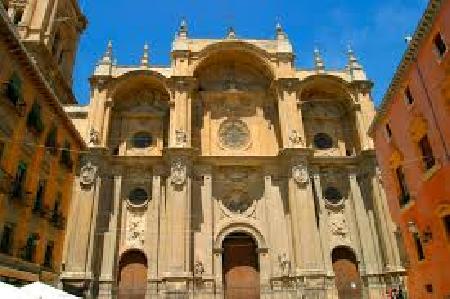 The Cathedral of Granada was built on the site of the destroyed Great Mosque, whose remains - La Madrasa - are in front of the Royal Chapel. There was once a 14th century Islamic madrasah, later rebuilt in the Baroque style and now part of the University of Granada (however, there is a wonderful prayer room). You can enter here to admire the magnificent stucco work. Another relic behind Calle de los Reyes, the Catholics, is the Corral del Carbón, an unusually strict building with an interior courtyard that served as a warehouse and permanent residence for merchants. Between this place and the cathedral is the Alcaicería, an old Arab market completely rebuilt after a fire. It is full of expensive memories. In the Main Chapel, you can see the figures of Fernando and Isabel praying for Pedro de Mena and the works of Alonso Cano.
The Cathedral of Granada was built on the site of the destroyed Great Mosque, whose remains - La Madrasa - are in front of the Royal Chapel. There was once a 14th century Islamic madrasah, later rebuilt in the Baroque style and now part of the University of Granada (however, there is a wonderful prayer room). You can enter here to admire the magnificent stucco work. Another relic behind Calle de los Reyes, the Catholics, is the Corral del Carbón, an unusually strict building with an interior courtyard that served as a warehouse and permanent residence for merchants. Between this place and the cathedral is the Alcaicería, an old Arab market completely rebuilt after a fire. It is full of expensive memories. In the Main Chapel, you can see the figures of Fernando and Isabel praying for Pedro de Mena and the works of Alonso Cano.
Sunlight penetrates through small arched stained glass windows. Visitors celebrate the temple's unusual golden aura. Columns, paintings, baguettes from paintings by famous artists, iconostasis - all this is lavishly decorated with gold, and even in the air the golden sparks flicker. Incidentally, the gold finish blends very harmoniously with the white walls.
The central part, the main chapel, is surrounded by golden white Corinthian columns. At the entrance, visitors are greeted by the sculptures of Isabel and Fernando. The vault is arranged with golden petals, filled with a green background, dotted with golden drops. The rows of windows are decorated with Flemish stained glass. Below is a series of large biblical-themed paintings, surrounded by much gold.
The focus is on the large statues created by the hands of the Spanish masters. The most valuable is considered the baroque statue of the Blessed Virgin Mary, created by the architect Alonso Cano. The painting was painted by the famous artist known as ¨El Greco¨ and José de Ribera.
Inside is a small museum, and the founder's personal belongings - Isabella Castilla - have been kept here for centuries. The Queen's private library has been preserved, and paintings and tapestries are displayed to decorate her rooms. The pearl of the collection is the crown with the nun's scepter.
To go see the masterpiece of Spanish architecture, it is recommended to dress modestly. Photographs can be taken throughout the cathedral, with the exception of the Royal Chapel. But judging by the photographic reports, the astute tourists manage to capture for themselves the incredible beauty of the tomb.
Throughout the week, the doors are open to tourists and parishioners from ten in the morning until seven thirty. On the last day of the week and on public holidays, the temple is only available from 3 pm to 6 pm. On holidays, concerts are held, and listeners enjoy choral singing and organ music performed in the magnificent acoustics of the temple.
Admission for adults and children over the age of twelve is subject to a fee. Those who wish to receive can receive an audio guide. The discount is for students only, admission is 3.5 euros, and very young visitors will be admitted free of charge.
Large groups or organized school visits are subject to prior agreement, for which the address must be notified by email.
The historic center is very small, in a square there are many historical buildings of different architecture. But going through the main Catholic temple is not possible anyway.
Address: Calle Gran Vía de Colón, 5, 18001 Granada, Spain
Telephone: +34 958 22 29 59
